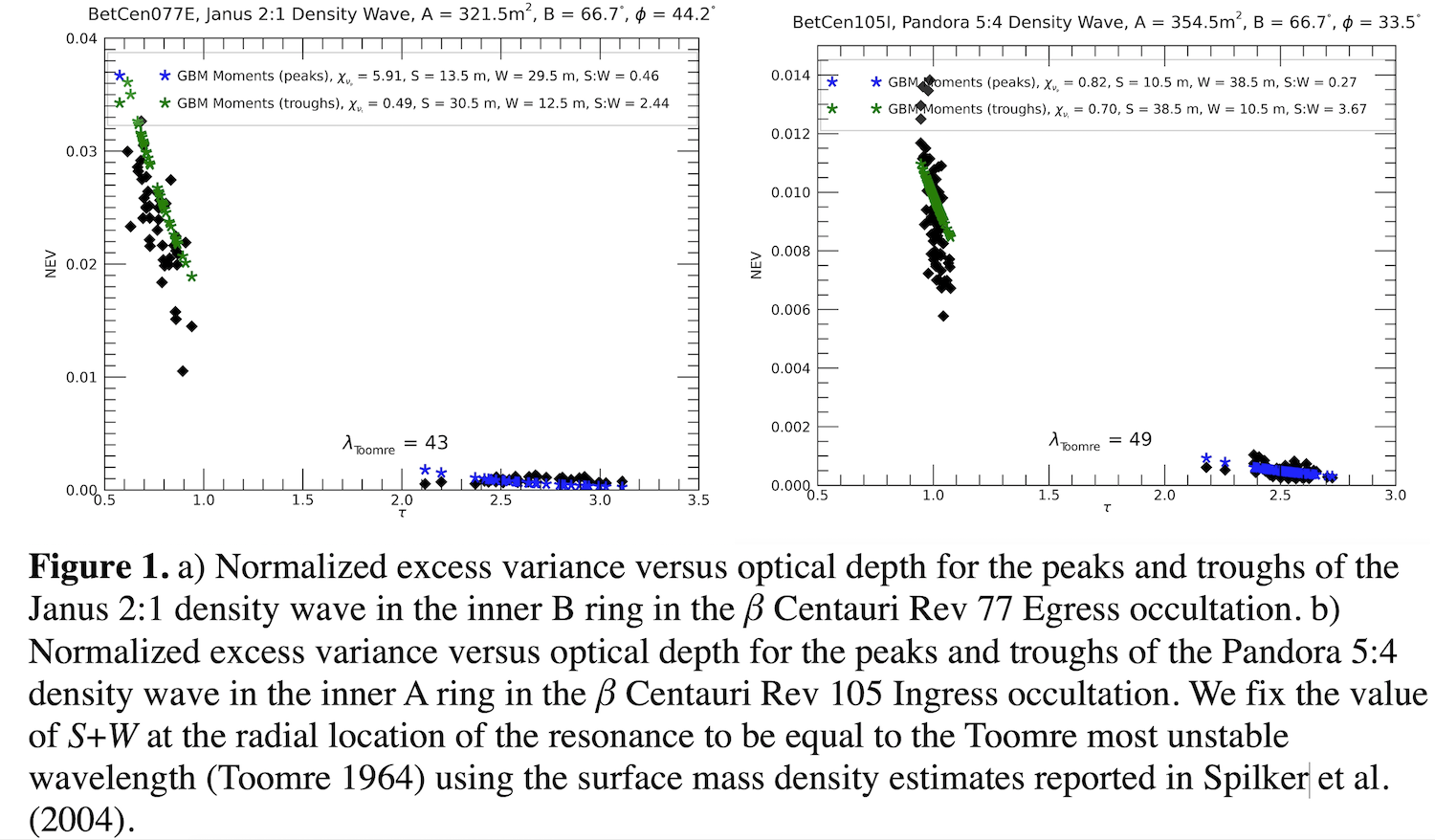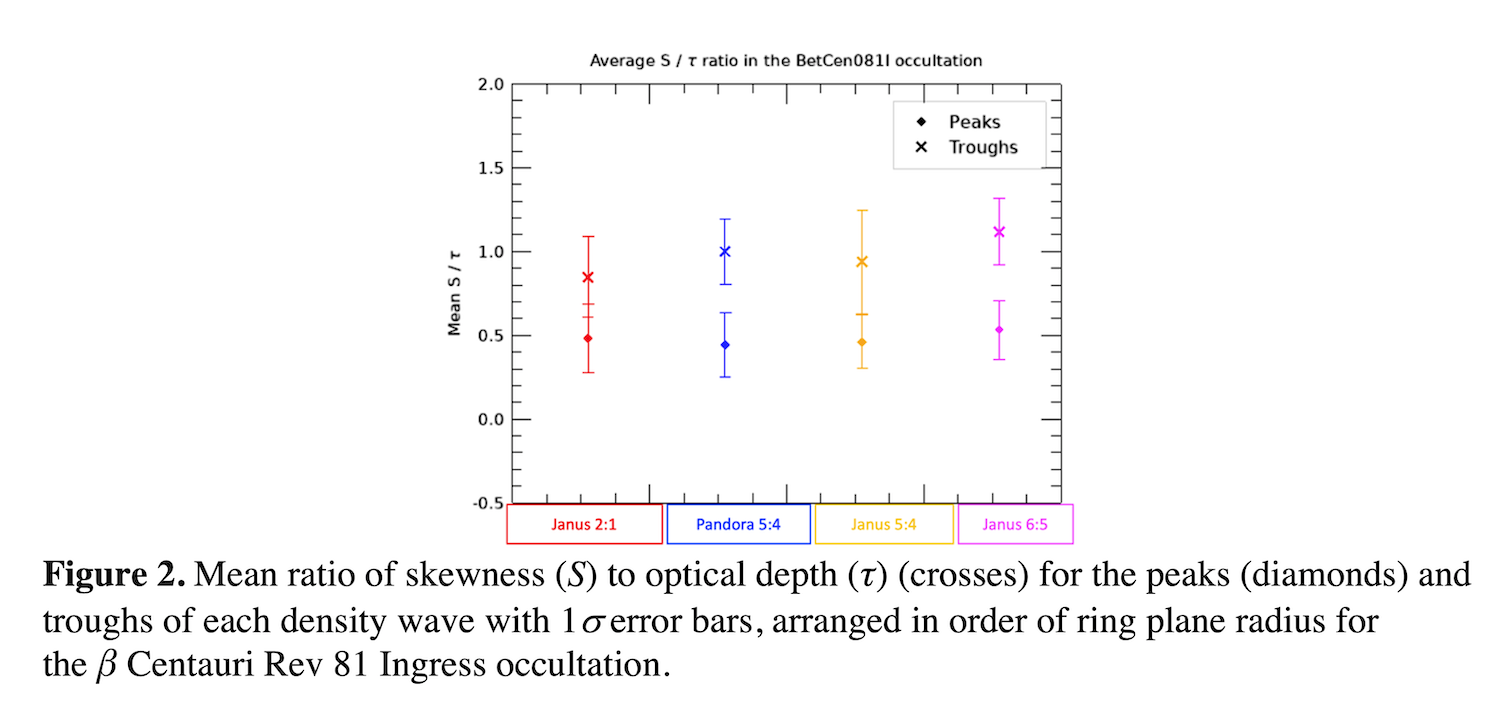- 1University of Central Florida, Orlando, FL, United States
- 2Laboratory for Atmospheric and Space Physics, Boulder, CO, United States
Cassini’s Ultraviolet Imaging Spectrograph (UVIS) observed 276 stellar occultations of Saturn’s rings over the course of its mission. During these occultations, UVIS’ High-Speed Photometer (HSP) collected photon count measurements through the rings at a typical radial resolution of 10 meters from a wide range of viewing angles. Because photon counts are Poisson distributed, the variance of the starlight is approximately equal to its mean in the absence of occulting ring material. When the star passes behind the rings from the point-of view of the spacecraft, the finite sizes of the ring particles result in an excess variance above the mean caused by correlation in the blocking of photons. Showalter and Nicholson (1990, Icarus, 87, 285) and Colwell et al. (2018, Icarus, 300, 150) interpreted this excess variance in terms of an effective particle or clump size, RE, which depends on the length scale of shadows cast by particles and clumps. In the A ring however, where ring particles aggregate into trailing spiral structures called self-gravity wakes (Colwell et al., 2006, Colwell et al., 2007, Hedman et al., 2007, Nicholson and Hedman (2010), the assumptions of Showalter and Nicholson (1990) and Colwell et al. (2018) of uncorrelated spherical particles are invalid.
Here we expand their analyses to account for the presence of self-gravity wakes, ephemeral agglomerations of ring particles under the competing influence of their mutual self-gravity and Keplerian shear, by introducing free parameters S(wake separation), and W (wake width) into a direct calculation of higher order statistical moments of excess variance, skewness, and kurtosis from the expectation value of the random variate, ring transparency (T). We use the granola bar model of self-gravity wakes (Colwell et al. 2006) to calculate the autocovariance of the measured signal. In this work we compare the values of these higher order moments in the peaks and troughs of the Janus 2:1, Pandora 5:4, Janus 5:4, and Janus 6:5 density waves, which exist in regions in which self-gravity wakes are prominent. We compare the best-fit combinations of S and W to the excess variance for many combinations of S and W from different ring regions to reveal trends in the variation of wake properties by ring region. The sum S+W is constrained by the measured dispersion of the waves which gives the local surface mass density. We use this value to determine the Toomre most-unstable wavelength which we assume to be equal to the self-gravity wake wavelength (S+W) (Julian and Toomre, 1966).

The second order moment, skewness (S), measures the asymmetry of the distribution and is indicative of either large clumps or small gaps in the rings nicknamed "ghosts" (Baillie et al., 2012). The presence of a few small gaps (high transparency outliers in the distribution) may lead to a positive skewness. The presence of too many gaps, however, increases the symmetry of the distribution as the gaps are no longer outliers. We take the ratio of S to τ to account for the correlation between the two variables (S is proportional to τ when τ ≳ 1). We occasionally observe that the ratio in the troughs differs by more than one standard deviation from the ratio in the peaks of the density waves. Our results indicate that either there are more gaps (positive outliers) present in the troughs than in the peaks or that there are so many gaps in the peaks that they no longer stand out as outliers of the distribution.

We apply this analysis technique to a multitude of occultations across a variety of ring elevation (B) and azimuthal (f) angles to survey wake parameter variation across these regions.
References
Baillié, K., Colwell, J.E., Lissauer, J.J., Esposito, L.W., Sremčević, M., 2011. Waves in Cassini UVIS stellar occultations 2: The C ring. Icarus 216, 292-308.
Colwell, J.E., et al., 2006. Gravitational wakes in Saturn’s A ring measured by stellar occultations from Cassini. Geophys. Res. Lett. 33.
Colwell, J.E., Esposito, L.W., Sremčević, M., Stewart, G.R., McClintock, W.E., 2007. Self-gravity wakes and radial structure of Saturn’s B ring. Icarus 190, 127-144.
Colwell, J. E., Esposito, L. W., Cooney, J. Particle sizes in Saturn’s rings from UVIS stellar occultations 1. Variations with ring region. Icarus 300, 150.
Hedman, M. M., et al., 2007. Self-gravity wake structures in Saturn’s A ring revealed by Cassini-VIMS. The Astronomical Journal 133(6), 2624-2629.
Jerousek, R. G., Colwell, J. E., Nicholson, P. D., Hedman, M. M., Esposito, L. W., 2016. Small Particles and Self-Gravity Wakes in Saturn’s Rings from UVIS and VIMS Stellar Occultations. Icarus 279, 36-50.
Julian, W.H. and Toomre, A. (1966). Non-axisymmetric responses of differentially rotating disks of stars. Astrophys. J., 146. 810-830.
Nicholson, P. D., and Hedman, M. M., 2010. Self-Gravity Wake Parameters in Saturn’s A and B Rings. Icarus 206, 410-423.
Showalter, M. R., and Nicholson, P. D., 1990. Saturn's rings through a microscope: Particle size constraints from the Voyager PPS scan. Icarus 87, 285-306.
Spilker, L. J., et al., 2004. Saturn A ring surface mass densities from spiral density wave dispersion behavior. Icarus 171, 372–390.
How to cite: Eckert, S., Colwell, J. E., Jerousek, R. G., Esposito, L. W., and Luthra, R.: Characterizing self-gravity wake morphology in Saturn’s rings from Cassini UVIS stellar occultation statistics, Europlanet Science Congress 2021, online, 13–24 Sep 2021, EPSC2021-860, https://doi.org/10.5194/epsc2021-860, 2021.

